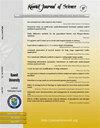纳米脉冲电流注入下CoFeB纳米带的缺口几何可调畴壁钉钉行为
IF 1.2
4区 综合性期刊
Q3 MULTIDISCIPLINARY SCIENCES
引用次数: 0
摘要
为了最优地控制铁磁纳米带中的畴壁钉钉行为,一些研究重点是利用几何缺口作为人工钉钉电位。大多数研究的目的是解释DW结构在通过或从缺口移出时的动力学。然而,对于纳米带中沟槽几何结构的影响,目前还缺乏讨论。本文从初始基态条件出发,利用微磁模拟研究了缺口几何形状对纳秒脉冲电流注入下畴壁可调性钉钉行为的影响。该材料的微磁模型模拟了具有完美单晶结构的CoFeB条纹纳米线的垂直磁化。DW的脱屑条件由DW的边缘决定,缺口区域不存在,这与缺口形成的纳米带中超过人工钉钉电位所需的最小能量有关。微磁结果表明,缺口深度的变化使脱屑电流密度值呈线性增加。此外,在20 nm以上,较小的纳米带狭缝模拟物的脱屑电流值随着缺口深度的增大而显著增加。在这种情况下,中等尺寸的纳米带几何形状和缺口尺寸对于有效地钉住和控制CoFeB纳米带中的DW是相当重要的。本文章由计算机程序翻译,如有差异,请以英文原文为准。
Tunable domain wall pinning behavior by notch geometry in CoFeB nanostrip under nano-pulse current injection
To optimally control the domain wall (DW) pinning behavior in the ferromagnetic nanostrip, some focus is on utilizing a geometrical notch as an artificial pinning potential. Most of the studies were intended to explain the dynamics of DW structure when it passes or moves out from the notch. However, there is still a lack of discussion about the effect of the geometrical structure of notches in the nanostrips. This work investigated the effect of notch geometry on the domain wall tunability pinning behavior under nanosecond pulse current injection using micromagnetic simulation from its initial ground-state condition. The micromagnetic model of the material mimicked the perpendicular magnetization of the CoFeB stripe-shaped nanowire with a perfect single crystalline structure. The DW depinning condition determined by the edge of DW leaves out the notch area, which was related to the minimum energy needed to surpass the artificial pinning potential in the nanostrip made by the notch. The micromagnetic results showed that the notch depth variation linearly increased the depinning current density value. Moreover, the depinning current value was significantly increasing on the smaller nanostrip slit analog to the larger notch depth above 20 nm. In this case, the medium size of nanostrip geometries and notch sizes are considerable for the effective DW pinning and control in the CoFeB nanostrip.
求助全文
通过发布文献求助,成功后即可免费获取论文全文。
去求助
来源期刊

Kuwait Journal of Science
MULTIDISCIPLINARY SCIENCES-
CiteScore
1.60
自引率
28.60%
发文量
132
期刊介绍:
Kuwait Journal of Science (KJS) is indexed and abstracted by major publishing houses such as Chemical Abstract, Science Citation Index, Current contents, Mathematics Abstract, Micribiological Abstracts etc. KJS publishes peer-review articles in various fields of Science including Mathematics, Computer Science, Physics, Statistics, Biology, Chemistry and Earth & Environmental Sciences. In addition, it also aims to bring the results of scientific research carried out under a variety of intellectual traditions and organizations to the attention of specialized scholarly readership. As such, the publisher expects the submission of original manuscripts which contain analysis and solutions about important theoretical, empirical and normative issues.
 求助内容:
求助内容: 应助结果提醒方式:
应助结果提醒方式:


